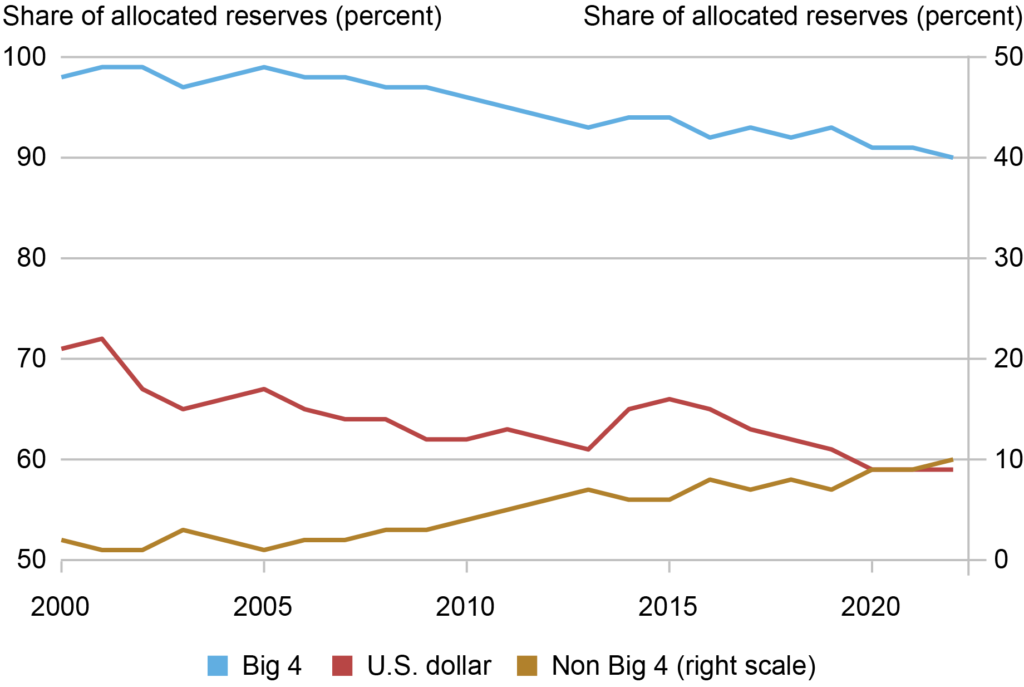Recent research from the New York Federal Reserve challenges the popular narrative about the dollar’s decline and the rise of gold. As of January, global central banks and finance ministries held nearly $12 trillion in foreign exchange reserves, with almost $7 trillion in U.S. dollar assets. The research disputes the idea that the increase in gold demand is a direct result of a move away from the dollar, suggesting that it is driven by the behavior of a small group of countries, such as the BRICS nations. The study emphasizes that the decline in the U.S. dollar global reserve share is primarily influenced by country-level changes, rather than a widespread effort to diversify away from the dollar.
Introduction
The dynamics of the global economy are constantly evolving, with shifts in global reserve currencies and investments having far-reaching implications. Recent research conducted by the New York Federal Reserve challenges prevailing narratives about the decline of the U.S. dollar and the rise of gold as a preferred asset. This article delves into the findings of this research and sheds light on the complexities of global reserve holdings and currency preferences.
Understanding Global Reserve Holdings
Global central banks and finance ministries collectively hold nearly $12 trillion in foreign exchange reserves, with a significant portion of these reserves – almost $7 trillion – allocated to U.S. dollar assets. Although the rise of gold as a reserve asset has been linked to a desire to move away from the dollar, the research posits that this trend is primarily driven by the actions of a select group of countries, notably the BRICS, rather than a widespread global shift away from the dollar.
Factors Driving Changes in Dollar Share
The research conducted by the New York Fed identifies two main factors that drive changes in the dollar’s share of aggregate reserves. First, changes in individual country preferences for holding dollar assets can influence the overall dollar share at a global level. Second, variations in the quantities of reserves held by different countries can impact global aggregates, particularly if those countries have initial dollar portfolio allocations that deviate from the average.
Insights from Country-Level Data
Analyzing country-level data on foreign exchange reserves and reserve composition provides valuable insights into the factors driving changes in the dollar’s share of reserves. Two key types of data – country foreign exchange reserves data from the IMF and country-level composition of reserves from researcher estimates – offer a comprehensive view of how individual countries contribute to the dynamics of global currency preferences.
Small Group of Countries Impact Dollar Share Decline
Contrary to the notion of a wholesale shift away from the U.S. dollar, data on estimated portfolio shares reveal a nuanced picture. While some countries have decreased their exposure to the dollar, others have actually increased their U.S. dollar asset portfolio shares. Notably, a small group of countries, including China, India, Russia, and Turkey, have played a significant role in driving the decline of the dollar’s aggregate share of reserves.
Regression Analytics and Determinants of Dollar Share
Regression analytics examined the contributions of various factors to the U.S. dollar share of country reserves. Factors such as currency pegs, bilateral trade shares with the U.S., euro area trade proximity, and debt exposures were found to be influential in shaping portfolio allocations. Traditional determinants continue to play a crucial role in countries’ decisions regarding currency holdings, underlining the importance of established economic relationships.
Gold’s Rising Prominence in Central Bank Reserves
Central banks across the globe have increasingly turned to gold as a reserve asset, particularly in the aftermath of the global financial crisis. The World Gold Council reports a significant uptick in gold purchases by central banks, with over 1,100 tons acquired in 2022 alone. This surge in demand for gold stems from its perceived value as an inflation hedge, risk hedge, and a tool to mitigate the impact of economic sanctions.
The Three Factors Driving Gold Demand
Market participants attribute the increased demand for gold by central banks to three primary factors. Firstly, gold is seen as a reliable hedge against inflation, preserving the value of central bank reserves in times of economic uncertainty. Secondly, it serves as a hedge against various risks, providing stability to central bank portfolios. Lastly, gold’s role as a sanctions hedge allows central banks to diversify their assets and safeguard against geopolitical challenges.
In conclusion, the research conducted by the New York Federal Reserve offers valuable insights into the dynamics of global reserve holdings, the evolving role of the U.S. dollar, and the increasing prominence of gold as a reserve asset. While some countries have indeed shifted their reserves away from the dollar, these changes are driven by specific factors and do not necessarily signal a broad-based abandonment of the U.S. currency. As central banks continue to navigate a complex economic landscape, understanding these nuances is crucial for informed decision-making and strategic reserve management.

